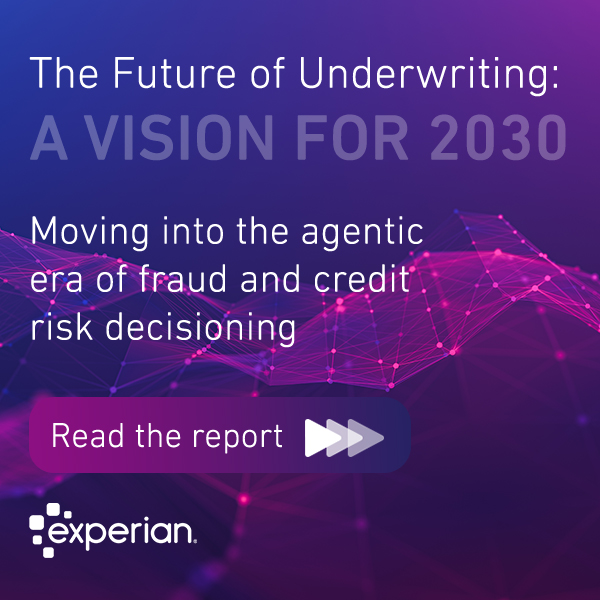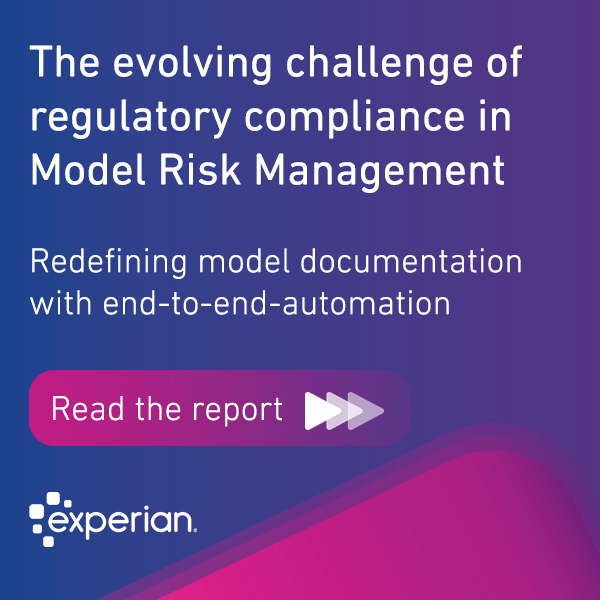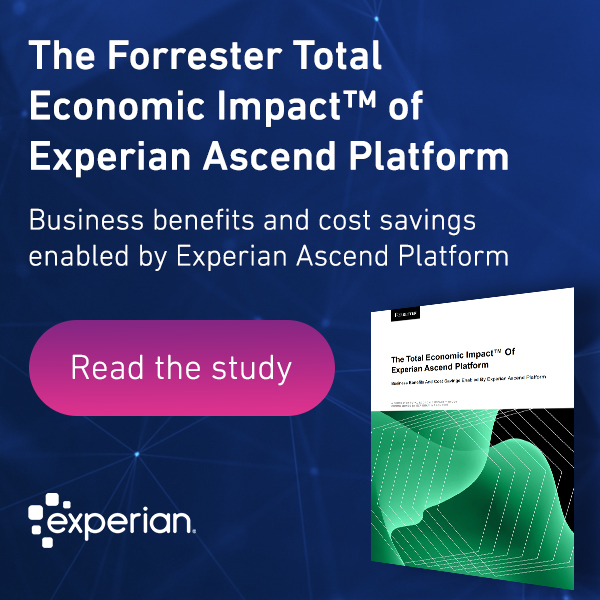All posts by Christopher Wilson, SVP, Portfolio Marketing, Experian Software Solutions

The credit landscape is undergoing a seismic shift. Consumers expect seamless, lightning-fast digital experiences, but financial institutions must also contend with rising fraud risks and intensifying regulatory pressure. Incremental tweaks won’t cut it – modern lending demands a radical rethink. In an era defined by AI, automation and data-driven insights, lenders have a unique opportunity: to transform credit operations from rigid and reaction, to agile, intelligent and scalable. When presenting our research, I’m often challenged to provide evidence of companies that have made this move and embraced this shift, not just to survive, but to lead. “What benefits did they actually see – in dollars and cents?” It’s a fair question, especially when the stakes are high and the path forward can seem uncertain. To answer it, Experian commissioned Forrester Consulting to conduct a Total Economic Impact™ study on the impact of Experian Ascend Platform with organisations that have made this move. The findings showcase how lending institutions are leveraging advanced analytics and automation to enhance credit operations, reduce fraud, and accelerate business growth. Download now The need for accurate and efficient credit operations has never been greater The challenges financial institutions face today: Manual, slow credit decisioning: Lengthy approval processes limit scalability and impact customer satisfaction. Lack of up-to-date data: On-premises environments can prevent accurate up-to-date data. Static scorecards and manual checks happen after the fact. Inconsistent underwriting decisions: Manual assessments introduce bias and inefficiencies. Rising fraud risks: The financial ecosystem faces increasing fraud threats that require real-time detection. Market volatility: Institutions must adapt faster to economic changes and regulatory requirements. Key findings from Forrester Total Economic Impact™ of Experian Ascend Platform Forrester’s independent research provides quantifiable insights into the financial impact of Experian Ascend Platform. The results are based on a composite organisation representative of interviewed customers over three years. 183% ROI with a $13.3M Net Present Value (NPV) 12-month payback period 12% improvement in approval rates over three years 5% year-over-year in new revenue from additional applications 67% efficiency gains in credit decisioning 20% reduction in default costs These numbers show institutions investing in Experian Ascend Platform see rapid, measurable returns. Real-world impact: How businesses are benefiting In addition to the data, the study includes real customer successes across industries: Car leasing company: Increased approval rates from 60% to 66%, leading to better risk management and higher conversion rates. Global airline: Reduced fraud chargebacks by 99.9% (from 6,660 cases per year to just 4), preventing financial losses and reputational damage. Fintech lender: Reduced model development time from months to days, improving agility in risk assessment. These organisations transformed their operations by replacing legacy systems with cloud-based, automation and advanced analytics that deliver real-time insights and consistent, scalable decision-making. "Experian Ascend Platform is driving revenue because more business is being accepted on an automated basis. It’s taking the decision away from the underwriters - making decisioning more consistent - and we are seeing less revenue erosion through successful fraud reporting."Credit Manager, Car Leasing How the Forrester Total Economic Impact™ study can help your business Financial leaders can use the Forrester Total Economic Impact™ of Experian Ascend Platform as a strategic decision-making tool to: Explore ROI potential: Start with the specific areas your business could benefit from using the Experian Ascend Platform, such as operational efficiency, faster decisions, or marketing effectiveness. Build a business case that resonates: Back your investment with proven results. Use real-world success metrics from organisations like yours to shape a compelling, data-driven case. Uncover new growth opportunities: Think beyond cost savings and efficiency gains. With automation and advanced analytics, there’s real potential to expand your portfolio, enter new markets, and deepen customer engagement. Mitigate risk with confidence: See how other businesses have successfully reduced fraud, defaults, and compliance risk. This study provides a data-driven framework to help financial institutions understand the value added to their business. Download the full Forrester Total Economic Impact™ of Experian Ascend Platform study to explore the potential financial impact on your business.

Experian’s latest research shows that the crisis of the past few years has yielded a new, savvier digital consumer. With the rapid move to online services amidst the pandemic, consumers worldwide adapted—and quickly. Fifty-three per cent of consumers say they have increased their online spending and transactions within the past three months, and 50% plan to increase it even more over the next few months. As online activity has surged, so too have consumer expectations for friction-free, secure transactions. More than 80% of consumers say a positive online experience makes them think more highly of the brand. And if businesses don't meet those expectations? Well, switching providers is only becoming easier . For financial service providers, the evolution of consumer behaviour presents both an opportunity and a challenge. It's never been more critical to ensure that digital experiences are convenient and frictionless. However, soon that will be the expectation and not the draw for new customers. Instead, finding unique ways to compete will be what separates the good from the great. Convenience versus risk In our latest survey, consumers ranked security, convenience, and ease of recognition as the top contributors to a positive online experience. All of these are vital components to providing a frictionless transaction. However, seamlessly logging in to a financial app, applying for credit, or managing a balance isn't yet the standard for every provider. Many traditional banks continue to play catch-up with digital upstarts, but consumers are becoming less tolerant of barriers to accessing services and products, with 23% saying that businesses aren’t meeting their expectations for digital experiences. This provides businesses with the opportunity to attract and retain new customers, especially those tired of manual account onboarding processes. For instance, leveraging emerging recognition tools adds to the convenience factor, limiting the time customers spend inputting data and streamlining the entire experience. But even as they continue to prioritise frictionless processes, businesses should be wary of sacrificing security or increasing their own risk. In our survey, 73% of consumers said that the onus is on businesses to protect them online. While they don't want security efforts that slow down their transactions, they expect the level of security to remain high nonetheless. On the business side, we've also seen providers creating friction-free options for lending—for example, in the Buy Now, Pay Later (BNPL) space—that enable consumers to access credit nearly immediately. But even with the convenience, there is still a need to manage affordability and ensure that these customers aren't introducing additional risk to credit models. Differentiate to retain customers: The growing role of rewards With all the innovation underway, a friction-free experience will become the standard. And it may already be so among digital-first businesses. This begs the question: If a secure, convenient experience is the norm for consumers, then how can businesses differentiate themselves? The next competitive differentiator will be how businesses reward customers for their loyalty. It's no longer enough to provide new customers with low-interest or no-interest credit on small purchases. Forward-looking financial services providers are getting far more creative with their rewards. For instance, businesses offering BNPL are enabling their customers to accumulate loyalty points for using the service with multiple retailers. Customers can then put those points to use as discounts on merchandise from the places they already love to shop. Data sharing and analytics play a significant role in this approach, allowing businesses to understand their customers' behaviours and personalise offers and rewards. Notably, our survey reveals that 83% of consumers say their awareness of how companies use their personal data for security, convenience, and personalisation has increased. Today's consumers are as digital as ever, and there's no going back. While friction-free may have been the differentiator before, it's rapidly becoming the standard. Going forward, financial services providers will need to find a new way to compete for savvy consumers who expect—and demand—secure, frictionless online experiences. Stay in the know with our latest research and insights:

The pandemic may have accelerated digital transformation across the world of financial services , but behind the scenes, banks and lenders still face a significant tech debt, and many organizations are committed to continuing the innovation. That's for good reason. Today's consumers increasingly expect a digital-first customer experience. The days of visiting a local bank branch to access financial services and products are fading away. Fintechs have risen to the occasion, transforming the market and meeting the growing digital demand. For traditional banks and lenders, waiting to innovate is no longer an option—it's a must to remain competitive. So what comes next? Here's a look at the technology trends that stand to impact and transform financial services as we advance. 1. The rapid rise of low-code/no-code solutions According to a recent survey from TechRepublic1, nearly half of companies are already using low-code/no-code solutions (LCNC). The same report also notes that among companies not using LCNC solutions, one in five plans to begin within the year. The driving force behind this trend is the global shortage of digital skills, from software development to data analytics to information security. The pool of technical talent has long been smaller than the demand, and the Great Resignation has only exacerbated the problem. For instance, 75% of software developers2 report they're currently looking for other jobs. Amidst this ongoing talent shortage, there's another stressor—the need to deploy technology products to market faster and faster. LCNC solutions answer these challenges by making doing so easier and quicker. The technology democratizes software development, allowing business users—or citizen developers—in different functions to design and deploy applications. With the skills gap likely to continue, the interest in LCNC solutions will too. LCNC solutions enable financial institutions to keep pace with technology changes and meet the digital demand, even with limited technical resources. 2. Leveraging data will require adding value—and engendering trust Financial service organizations have used advanced data analytics to provide consumers with more personalized products. And consumers have been on board as long as they see the benefit. For example, a 2021 consumer survey by Experian showed that 42% of consumers would share personal data, and 56% would share contact information, if it improves their experience. However, this research speaks to growing tension between consumers and financial service providers. The first want more personalized services, but they are also more selective about which companies they share data with. Consider a recent McKinsey study that revealed that 44% of consumers don't fully trust digital services3. As we advance, organizations that want to build and keep consumer trust will need to be thoughtful about the data they ask for and increasingly transparent about how they plan to use it. 3. Doubling down on AI but looking for ROI in the process AI has proven helpful in multiple ways, from powering recommendation engines and chatbots within the retail world to improving fraud analysis and prevention in the banking industry. But there's still so much more organizations can do, especially with the AI they already have. Financial service and fintech companies have funneled massive resources into AI solutions. However, only 20% of AI models4 are ever used in widespread deployment. What’s more, the current average return on AI investments hovers around 1%. This year, expect to see more organizations examining the ROI of AI-powered technology and looking to get more from the investments they've made. Technology partners can help by identifying additional opportunities for AI models to drive customer engagement, validate credit scoring, and protect businesses against fraud. 4. Banking-as-a-Service will yield even more choices and more competition There have long been high barriers that protect traditional financial service organizations from much new competition. But the advent of open APIs and Banking-as-a-Service (BaaS) is knocking these barriers down, yielding a considerable influx of startups that provide banking-like services. And this wave of new fintech has captured consumer interest. Consumers have shown that they’re willing to try financial service products from an array of providers; they're not married to sticking with traditional banks. In fact, 27% of global consumers5 have relationships with neobanks, and 40% report using financial apps6 outside of their primary banking app. However, the gold rush towards BaaS will yield a few winners and a lot of losers. The question for the near-term is who will survive in this crowded market. Consumers will also begin to figure out what makes sense in terms of how many financial organizations they want to connect with and when to say enough is enough. 5. Embedded finance is the new black in retail In a similar theme, the influx of embedded finance products into retail experiences continues to gain traction. There's only more to come. Multiple leading retailers, both longstanding and new D2C brands, have incorporated Buy Now Pay Later (BNPL) payment options into their checkout process, and shoppers are rapidly adopting these new payment methods. One-third of consumers report they've used BNPL before7. Though the payment method still lags far behind other forms of credit, awareness of BNPL and other embedded finance solutions is rising, especially among younger consumers. Looking forward, expect to see embedded finance make inroads not only with more retailers but also across other industries such as hospitality or entertainment. These pressing tech trends are reshaping financial services. In the process, they're bringing new solutions to consumers and new opportunities to banks and non-traditional lenders. Organizations that keep pace with these trends will lay the foundation for their next generation of customers as well as the future of their business. More 2022 trends and predictions Stay in the know with our latest research and insights: 1.TechRepublic Survey: Low-code and no-code platform usage increases 2.Stack Overflow: The Great Resignation is here. What does that mean for developers? 3.McKinsey: Are you losing your digital customers? 4.ESI ThoughtLab: Driving ROI through AI 5.EY: How can banks transform for a new generation of customers? 6.Axway: Consumers are starting to sense an open banking transformation 7.PYMNTS.com: No slowdown in sight for surging BNPL as consumers want it, retailers need it




